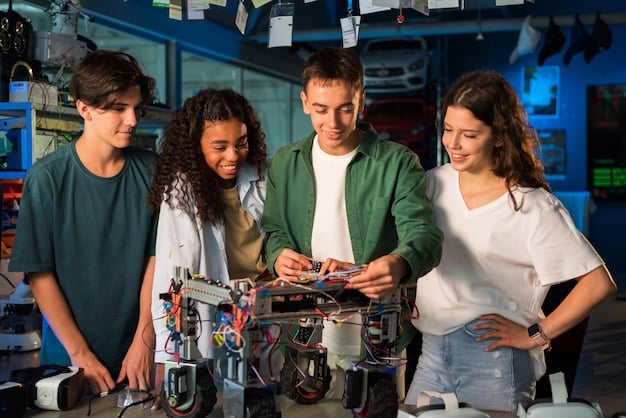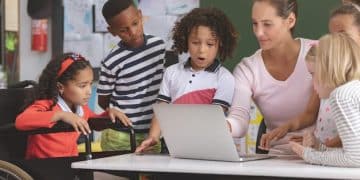Schools & Partnerships: Boosting Learning Opportunities

Schools are enhancing learning opportunities by forging strategic partnerships with businesses and community organizations, leveraging resources, expertise, and real-world experiences to enrich the educational environment.
In today’s rapidly evolving world, education extends far beyond the traditional classroom. Discover how schools are partnering with businesses and community organizations to enhance learning opportunities, creating a more dynamic and relevant educational experience for students.
The Growing Need for External Partnerships in Education
The educational landscape is undergoing a significant transformation, driven by the need to prepare students for a complex and interconnected world. Traditional classroom learning, while essential, often lacks the real-world application and diverse perspectives necessary for holistic development. This is where external partnerships become invaluable. Schools are increasingly recognizing that collaborations with businesses and community organizations can provide students with a more enriched, relevant, and engaging learning experience. These partnerships can bridge the gap between theoretical knowledge and practical application, offering students opportunities to explore career paths, develop essential skills, and contribute to their communities.
Why Partnerships Matter
Partnerships between schools and external organizations are not just add-ons; they are integral to fostering a well-rounded education. These collaborations bring a wealth of resources, expertise, and real-world experiences that can significantly enhance the learning environment. By working with businesses, schools can offer students internships, mentorship programs, and insights into various industries. Community organizations, on the other hand, can provide opportunities for service learning, cultural enrichment, and community engagement. These partnerships create a symbiotic relationship where students, schools, and the community benefit from shared knowledge and resources.

Moreover, external partnerships help to address the skills gap that often exists between academic learning and the demands of the workforce. By working closely with businesses, schools can align their curricula with industry needs, ensuring that students graduate with the skills and knowledge that employers are seeking. This not only improves students’ career prospects but also contributes to the economic growth of the community. The partnerships also play a crucial role in fostering social responsibility and civic engagement. Through service learning projects and community initiatives, students learn the importance of giving back and making a positive impact on society.
In conclusion, the growing need for external partnerships in education is driven by the desire to provide students with a more comprehensive, relevant, and engaging learning experience. These collaborations offer a multitude of benefits, including access to resources, real-world experiences, and opportunities for career exploration and community engagement. As education continues to evolve, partnerships between schools, businesses, and community organizations will undoubtedly play an increasingly important role in shaping the future of learning.
Types of Business Partnerships Enhancing School Programs
Business partnerships are reshaping the educational landscape by providing schools with resources, expertise, and real-world opportunities that traditional funding models often cannot support. These partnerships can take many forms, each offering unique benefits to students and the community. From providing financial support and resources to offering mentorship programs and hands-on learning experiences, businesses are playing a crucial role in enhancing school programs and preparing students for future success.
Here are a few types of impactful business partnerships:
- Financial Support and Resources: Many businesses provide financial support through donations, sponsorships, and scholarships, which can help schools fund extracurricular activities, purchase new equipment, and upgrade facilities.
- Mentorship Programs: Business professionals volunteer their time to mentor students, offering guidance and support in academic and career planning. These programs provide students with valuable insights into various industries and help them develop essential skills.
- Internships and Apprenticeships: Businesses offer internships and apprenticeships that allow students to gain hands-on experience in real-world settings. These opportunities provide students with practical skills and a deeper understanding of the workplace.
- Curriculum Development: Businesses collaborate with schools to develop curriculum that is aligned with industry needs, ensuring that students graduate with the skills and knowledge that employers are seeking.
The impact of these partnerships can be profound. For example, a local tech company might partner with a high school to offer coding workshops, providing students with in-demand skills and opening doors to future career opportunities. A manufacturing firm might collaborate with a vocational school to create an apprenticeship program, giving students hands-on training in advanced manufacturing techniques. These partnerships not only enhance the quality of education but also strengthen the ties between schools and the business community.
Ultimately, business partnerships are a win-win situation for everyone involved. Schools benefit from access to resources and expertise, businesses benefit from a pipeline of skilled workers, and students receive a more relevant and engaging education. As the demands of the workforce continue to evolve, these partnerships will become increasingly important in ensuring that students are prepared for the challenges and opportunities of the future.
Community Organizations: Vital Partners in Student Development
Community organizations play a pivotal role in supporting student development by providing a wide array of services and programs that complement traditional classroom education. These organizations often focus on addressing the social, emotional, and physical needs of students, creating a supportive ecosystem that fosters academic success. Collaborations between schools and community organizations can take many forms, each offering unique benefits to students and the community. From providing after-school programs and mentorship to offering health services and family support, community organizations are vital partners in student development.
Types of Community Organizations
Schools often partner with these community organizations:
- After-School Programs: These programs provide students with a safe and structured environment after school hours, offering academic support, enrichment activities, and opportunities for recreation.
- Mentorship Programs: Community organizations offer mentorship programs that pair students with adult role models who provide guidance, support, and encouragement.
- Health Services: Many community organizations provide health services, such as medical and dental care, mental health counseling, and health education, to students who may not otherwise have access to these services.
- Family Support Services: Community organizations offer family support services that help parents and caregivers provide a stable and nurturing home environment for their children.
One exemplary model involves a local Boys & Girls Club partnering with an elementary school to offer after-school tutoring and enrichment activities. This collaboration not only provides students with additional academic support but also exposes them to a variety of cultural and recreational opportunities. Another successful partnership might involve a community health center working with a high school to provide health screenings, vaccinations, and health education workshops. These initiatives promote student well-being and help to create a healthier school environment. Furthermore, collaborations between schools and community organizations can help to address issues such as poverty, food insecurity, and homelessness, which can have a significant impact on student learning and development.
To summarize, community organizations are indispensable partners in student development, offering a wide range of services and programs that support the holistic needs of students. By working together, schools and community organizations can create a network of support that empowers students to succeed academically, socially, and emotionally.

Successful Partnership Models: Case Studies
Examining successful partnership models between schools, businesses, and community organizations provides valuable insights into how these collaborations can be structured and implemented effectively. These case studies highlight the diverse approaches that schools are taking to enhance learning opportunities for their students. By analyzing these models, educators and community leaders can gain a better understanding of the key factors that contribute to successful partnerships and adapt these strategies to their own unique contexts.
Case Study 1: High-Tech High and Qualcomm
High-Tech High, a network of charter schools in San Diego, has forged a strong partnership with Qualcomm, a leading technology company. Qualcomm provides High-Tech High with financial support, technology resources, and access to its engineers and scientists. These resources enable High-Tech High to offer students hands-on learning experiences in STEM fields, preparing them for future careers in technology. The partnership also includes mentorship programs, internships, and research opportunities, giving students invaluable exposure to the world of technology.
Case Study 2: Communities In Schools
Communities In Schools (CIS) is a national organization that partners with schools to provide comprehensive support services to students and their families. CIS works with schools to identify students who are at risk of dropping out and connects them with resources and services such as mentoring, tutoring, and health care. CIS also provides family support services, such as parenting classes and assistance with housing and employment. This holistic approach helps to address the root causes of academic challenges and empowers students to succeed in school and in life.
A key element of successful partnership models is a shared vision and clear goals. All partners must be aligned in their goals and objectives and have a clear understanding of their roles and responsibilities. Open communication and collaboration are also essential for building trust and fostering a strong working relationship. Regular meetings and feedback sessions can help to ensure that the partnership is on track and that any challenges are addressed promptly. Finally, it is important to evaluate the impact of the partnership on student outcomes. Data should be collected and analyzed to determine whether the partnership is achieving its goals and to identify areas for improvement. These case studies exemplify how effective partnerships can transform the educational landscape, offering students unparalleled opportunities and fostering their holistic development.
Overcoming Challenges in Building and Maintaining Partnerships
While partnerships between schools, businesses, and community organizations offer numerous benefits, building and maintaining these collaborations can present significant challenges. Addressing these challenges requires careful planning, open communication, and a commitment to building strong and sustainable relationships. Understanding the potential pitfalls and implementing strategies to overcome them is crucial for the success of any partnership.
Common challenges include:
- Lack of Time and Resources: Schools and organizations often struggle with limited time and resources, making it difficult to dedicate the necessary attention to building and maintaining partnerships.
- Conflicting Priorities: Schools, businesses, and community organizations may have different priorities and goals, which can lead to conflicts and misunderstandings.
- Communication Barriers: Poor communication and a lack of transparency can undermine trust and lead to misunderstandings among partners.
- Sustainability Concerns: Partnerships may be vulnerable to changes in leadership, funding, or priorities, making it difficult to ensure long-term sustainability.
The first step in overcoming these challenges is to establish clear goals and expectations. All partners should have a shared understanding of the purpose of the partnership and their respective roles and responsibilities. Regular communication and feedback sessions can help to ensure that everyone is on the same page and that any issues are addressed promptly. Building trust is also essential for a successful partnership. This requires transparency, honesty, and a willingness to listen to and respect the perspectives of all partners. Schools and organizations should also invest in professional development and training to equip staff with the skills and knowledge needed to build and maintain effective partnerships. This might include training in communication, conflict resolution, and partnership development. Finally, it is important to develop a sustainability plan that addresses potential challenges and ensures that the partnership can continue to thrive in the face of change. This might involve diversifying funding sources, building strong relationships with key stakeholders, and documenting the impact of the partnership on student outcomes. By proactively addressing these challenges, schools and organizations can build strong and sustainable partnerships that provide students with invaluable opportunities and support their holistic development.
The Future of Education: Strengthening Collaborative Networks
The future of education hinges on the ability of schools to strengthen collaborative networks with businesses and community organizations. As the demands of the workforce continue to evolve and the needs of students become more complex, these partnerships will become increasingly essential for ensuring that students are prepared for success. The most promising trend in education is the growing recognition of the importance of partnerships and the increasing number of schools that are actively seeking to build and maintain these collaborations.
Here’s what to expect:
- Increased Investment: Governments, foundations, and corporations are likely to increase their investment in partnerships between schools, businesses, and community organizations.
- Technological Integration: Technology will play an increasingly important role in facilitating partnerships, enabling schools and organizations to connect and collaborate more effectively.
- Personalized Learning: Partnerships will support personalized learning approaches, allowing students to pursue their interests and develop their unique talents and skills.
- Community Hubs: Schools will evolve into community hubs, providing a wide range of services and support to students and their families.
Strengthening collaborative networks also requires a shift in mindset among educators, policymakers, and community leaders. Schools must move away from a siloed approach to education and embrace a more collaborative and community-centered model. This requires a willingness to share resources, expertise, and decision-making power with external partners. Policymakers must create a supportive policy environment that encourages and incentivizes partnerships. This might include providing funding for partnership development, reducing regulatory barriers, and recognizing schools and organizations that are actively engaged in collaborative initiatives. Finally, community leaders must advocate for partnerships and promote the value of collaboration to the broader community. This requires raising awareness of the benefits of partnerships, fostering a culture of collaboration, and mobilizing community resources to support schools and students. Ultimately, the future of education depends on our collective ability to build strong and sustainable collaborative networks that empower students to succeed in school, in work, and in life.
| Key Point | Brief Description |
|---|---|
| 🤝 Business Partnerships | Enhance programs through funding, mentoring, internships, and curriculum development. |
| 🏘️ Community Organizations | Support student development with after-school programs, health services, and family assistance. |
| 🌟 Partnership Models | Successful collaborations require shared goals, communication, and regular evaluations. |
| 🚀 Future Trends | Increased investment, tech integration, & community hubs will shape education’s future. |
Frequently Asked Questions
▼
School partnerships are crucial because they provide enriched learning experiences, access to resources, and create real-world connections. They help students develop skills and knowledge relevant to their futures.
▼
A wide range of businesses partner with schools, including tech companies offering coding workshops, manufacturing firms providing apprenticeships, and local businesses supporting extracurricular activities.
▼
Community organizations offer essential support through after-school programs, mentorship, health services, and family support, addressing students’ holistic needs and promoting academic success.
▼
Challenges include limited resources, conflicting priorities, and communication barriers. Successful partnerships require clear goals, open communication, trust, and long-term sustainability planning.
▼
The future involves increased investment, technological integration, personalized learning, and schools evolving into community hubs. These collaborations will be vital for preparing students for future success.
Conclusion
In conclusion, the partnerships between schools, businesses, and community organizations are essential for enhancing learning opportunities and preparing students for a dynamic future. By overcoming challenges and embracing collaboration, we can create a more enriched and supportive educational ecosystem.





